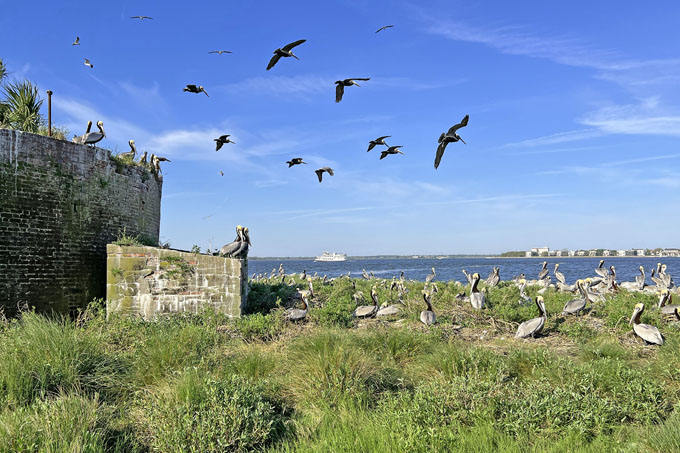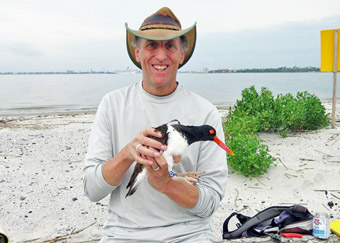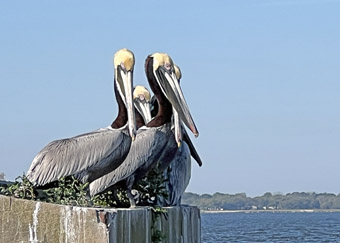A team of six scientists is participating in a four-month-long project to study coastal birds residing in and near Charleston Harbor, including Eastern Brown Pelicans and American Oystercatchers at the Castle Pinckney site. The project began in April and will end in July.
Updates will be posted on this website each month during the project.

The Castle Pinckney site, one of the nesting areas for Eastern Brown Pelicans and American Oystercatchers
“Our objective is to evaluate the bioaccumulation of a wide range of per-and polyfluoroalkyl substances (IPFAS) in local food webs that support coastal birds in and around the harbor,” said Dr. Patrick Jodice, the project’s leader. “We will measure these contaminants in Eastern Brown Pelicans and American Oystercatchers, and collect eggs, no more than one per nest, feathers and other samples from the birds to measure these contaminants.

Dr. Patrick Jodice, holding an American Oystercatcher, a bird that nests at the inland end of Schute’s Folly adjacent to the Castle Pinckney site.
“We also will attach tracking devices to identify their use areas. These tags will provide GPS locations via satellites and relay samples from throughout the harbor as well as the Ashley, Cooper and Wando rivers to assess contaminant exposure throughout the food webs of the birds.”
A Big Deal for the Coastal Birds Nesting at Castle Pinckney
This project is a big deal for the coastal birds, including the hundreds of Eastern Brown Pelicans and American Oystercatchers that nest at Castle Pinckney, according to Dr. Jodice, a Wildlife Research Biologist with the U.S. Geological Survey, S.C. Cooperative Fish and Wildlife Research Unit, and a Professor in the Department of Forestry and Environmental Conservation, Clemson University.

A small group of Eastern Brown Pelicans, among hundreds residing at the Castle Pinckney site, perches on the fort’s exterior wall.
The project will include the most extensive tracking effort for American Oystercatchers ever to be conducted in the state.
Other scientists, participating in the project led by Dr. Jodice, include: Dr. Rainer Lohman, Professor of Oceanography, University of Rhode Island (Principal Investigator); Dr. Juliet Lamb, Marine Scientist, The Nature Conservancy (Co-Principal Investigator); Dr. Patrick Jodice, Research Wildlife Biologist, SC Cooperative Fish & Wildlife Research Unit (Co-Principal Investigator); Ms. Amber Litterer, Research Associate, Department of Forestry and Environmental Conservation, Clemson University; and Ms. Rachel Adams, Graduate Research Associate, Department of Oceanography, University of Rhode Island.
“We will be attaching tracking devices, capable of providing GPS locations via satellites and relay data to the team via cell towers, to identify the birds’ use areas,” Dr. Jodice explained. “So, we expect to learn a substantial amount about their daily movement patterns that can then be used by DNR and others to better manage and conserve the species and its habitat. We have tracked a number of Pelicans in the past, but these new tags will provide more locations per day ─ a location every 5-10 minutes versus the rate tags provided in the past, 1 location per 2 hours ─ that will allow us to get a much better idea of the detailed movements they make.”
This project was developed to focus specifically on Charleston Harbor.
“Previous research suggests that the harbor may have elevated concentrations of the contaminants I’ve already mentioned, based on snapshot studies of other environmental and biological variables conducted by others,” Dr. Jodice said. “Therefore, having nesting areas within the harbor provides us an opportunity to measure these contaminants from a top-level predator within this system. Because our study species nest on the island, they’re included in this study.
“In a broader sense, however, nesting sites for coastal birds are quite limited in the state,” he added. “Pelicans only nest on a few islands in the state, and the Castle Pinckney site is one of them. Our lab has been studying pelicans here in South Carolina since 2004, and we have often included Crab Bank and Castle Pinckney as part of our research program. Oystercatchers nest a bit more broadly than pelicans within the state, but having islands that are free from mammalian predators is important to their overall success.”
The project is being funded by the Department of Defense’s Strategic Environmental Research and Development Program. Logistical and field support is being provided by The S.C. Department of Natural Resources.
The project’s scientific team is scheduled to pursue tasks at the Castle Pinckney site as follows:
Phase One, beginning in April ─ Monitor Oystercatcher nesting, collecting eggs, tagging individuals, and scoping for sampling sites for environmental variables.
Phase Two, beginning in May ─ Finish collecting Oystercatcher eggs and tagging individual birds; begin collecting environmental samples; monitor pelican nesting and begin collecting eggs and tagging individuals.
Phase Three, beinning in June ─ Finish collecting pelican eggs and tagging individuals; continue collecting environmental samples.
Phase Four, beginning in July ─ Collect any remaining environmental samples.
